Water Resources and Water Quality Assessment, Central Bamyan, Afghanistan
Abstract
1. Introduction
2. Materials and Methods
2.1. Description of the Study Area
2.1.1. General Characteristics
2.1.2. Geological Setting
2.2. Sampling
2.3. In-Situ Measurements and Laboratory Analysis
2.4. Development of a Water Quality Index (WQI)
3. Results and Discussion
3.1. General Status of Water Resources in the Bamyan Area
3.2. Assessment of Water Quality Index (WQI)
3.3. Correlation Matrix
4. Conclusions and Recommendations
- (a)
- Geologically, we divided Bamyan District into two main basins: the southern and northwestern parts. Generally, the southern basin that is recharged by snow and glacier melt from the Kuhi-Baba Mountains has good water quality compared that of the to the northwestern basin that has different geology and topography with less snow and glacier coverage. The southern basin has metamorphic and magmatic basement hard rocks with little or no soil cover, a clayey substrate, and carbonate sediments. In contrast, the northwestern basin consists mostly of carbonate rocks and some shale, marl, volcanic, and granitic rocks. However, the role of bedrock and sediments on water quality is very complex and this needs a more detailed geochemical analysis and assessment to be performed. In addition, all of the basins showed a clear decreasing trend of water quality from the upper to lower reaches.
- (b)
- Water supply systems, defined as simple piped water or reservoirs that recharge from springs, rivers, or wells, which have little protection and sanitation treatment, constitute only 15% of the water supplies to Bamyan communities, and these are mostly in urban areas (Table 1). These systems are operated largely by private companies and local communities and are too expensive for ordinary people to use. Many systems have failed to provide enough water for customers after several years and others failed during summer or winter. Due to the growing population and water scarcity in some areas during summer and winter, the need for the reliable regulation of public drinking water is evident, especially in urban areas. Water supply systems in rural areas remain primitive, as most are connected to unprotected canals or rivers. Therefore, we suggest the establishment of a central water quality monitoring authority within the Bamyan Water and Energy Department to regulate and control the public water supply systems.
- (c)
- Dug wells, which are the second most important source of drinking water, are widely used in Bamyan. The water table is generally high in most parts of Bamyan; therefore, some wells reach water that is only a few meters deep. We surveyed wells that were from 1 m up to 50 m deep in different parts of Bamyan. It appears that, with time, the wells have been drilled deeper as more wells have become more developed. The quality of the water in these wells is generally good to excellent. Many of the wells were open and some receive inputs of surface water, while others were contaminated by natural brines or human activities. High levels of EC and TDS in the samples from many of the unprotected wells indicate that there was contamination from the walls of wells. We surveyed two types of wells—private and community wells. The quality of the water in the private wells is generally better than it is in community wells due to the overuse of the latter. In rural areas, where surface water is available, few wells are operational, especially where water supply systems are functioning.
- (d)
- Canals are widespread, especially in rural areas, and they are basically used for irrigation. Many communities use water from these canals for washing and sometimes, if other sources are lacking, for drinking. Most of the canals originate from rivers and streams, with only a few receiving water from springs and reservoirs. The canals typically have the worst water quality, which is reflected in its color, turbidity, and high TDS and EC. Due to this obvious high level of contamination, we tested a limited number of samples from these sources.
- (e)
- Rivers are very important sources of water in Bamyan and almost all of the valleys in the region have a river or stream. The WQI of the rivers was mostly fair with some samples being in the good to excellent category. In the upstream areas where the rivers originate from fresh water sources like snow or glaciers, the water has a good WQI with low EC and TDS. However, the WQI in those that are downstream and near agricultural fields and populated communities is as low as it is in the canals. In some upstream rivers, we observed low pH (slightly acidic) water, which may be related to host rocks or basin sediments or mixing with hydrothermal brines.
- (f)
- Fresh water sources, including springs and snow/glacier melting, are minor sources that only some rural areas directly use. Springs that are connected to glaciers or the upstream reaches of rivers have a good WQI with low EC and TDS values, but there are thermal, salty, carbonate, and other types of springs that have high EC and TDS values and a low pH due to the dissolved solids and metal content in them. Some hydrothermal brines (Paymuri and Azhdar springs) introduce considerable amounts of toxic elements (e.g., As and Ba) into rivers that change their quality from good to poor.
- (g)
- Finally, based on the WQI assessment and accessibility, we suggest that the upper reaches of the Ahangaran, Sadat, and Qazan Rivers are the best sources for a central public drinking water supply system for Bamyan City.
Author Contributions
Funding
Data Availability Statement
Acknowledgments
Conflicts of Interest
References
- Nnorom, I.C.; Ewuzie, U.; Eze, S.O. Multivariate statistical approach and water quality assessment of natural springs and other drinking water sources in Southeastern Nigeria. Heliyon 2019, 5, e01123. [Google Scholar] [CrossRef] [PubMed]
- Tyagi, S.; Sharma, B.; Singh, P.; Dobhal, R. Water quality assessment in terms of Water Quality Index. Am. J. Water Resour. 2013, 1, 34–38. [Google Scholar] [CrossRef]
- Mishra, A.P.; Khali, H.; Singh, S.; Pande, C.B.; Singh, R.; Chaurasia, S.K. An assessment of in-situ water quality parameters and its variation with Landsat 8 level 1 surface reflectance datasets. Int. J. Environ. Anal. Chem. 2021, 1–23. [Google Scholar] [CrossRef]
- World Health Organization. Guidelines for Drinking-Water Quality: Second Addendum; World Health Organization: Geneva, Switzerland, 2008; Volume 1, Recommendations.
- Pande., C.B.; Moharir, K.N.; Singh., S.K.; Dzwairo, B. Groundwater evaluation for drinking purposes using statistical index: Study of Akola and Buldhana districts of Maharashtra, India. Environ. Dev. Sustain. 2020, 22, 7453–7471. [Google Scholar] [CrossRef]
- Kouadri, S.; Pande, C.B.; Panneerselvam, B.; Moharir, K.N.; Elbeltagi, A. Prediction of irrigation groundwater quality parameters using ANN, LSTM, and MLR models. Environ. Sci. Pollut. Res. 2022, 29, 21067–21091. [Google Scholar] [CrossRef]
- Gadil, A. Drinking water in developing countries. Ann. Rev. Energy Environ. 1998, 23, 253–286. [Google Scholar]
- Kualiti, P.; Minuman, A.; Sungai, L.; Turki, E. Drinking water quality assessment of Ergene River basin (Turkey) by Water Quality Index: Essential and toxic elements. Sains Malays. 2019, 48, 2071–2081. [Google Scholar]
- Panneerselvam, B.; Muniraj, K.; Duraisamy, K.; Pande, C.; Karuppannan, S.; Thomas, M. An integrated approach to explore the suitability of nitrate-contaminated groundwater for drinking purposes in a semiarid region of India. Environ. Geochem. Health 2022, 1–17. [Google Scholar] [CrossRef]
- Etim, E.E.; Odoh, R.; Itodo, A.U.; Umoh, S.D.; Lawal, U. Water quality index for the assessment of water quality from different sources in the Niger Delta Region of Nigeria. Front. Sci. 2013, 3, 89–95. [Google Scholar]
- Ketata, F.H.M.; Bouhlila, R.; Gueddari, M. Hydrogeochemical characteristics and assessment of drinking water quality in Zeuss-Koutine aquifer, southeastern Tunisia. Environ. Monit. Assess. 2011, 174, 283–298. [Google Scholar] [CrossRef]
- Khan, R.; Jhariya, D.C. Groundwater Quality Assessment for Drinking Purpose in Raipur City, Chhattisgarh Using Water Quality Index and Geographic Information System. J. Geol. Soc. India 2017, 90, 69–76. [Google Scholar] [CrossRef]
- Memon, M.; Soomro, M.S.; Akhtar, M.S.; Memon, K.S. Drinking water quality assessment in Southern Sindh (Pakistan). Environ. Monit. Assess. 2011, 177, 39–50. [Google Scholar] [CrossRef] [PubMed]
- Meride, Y.; Ayenew, B. Drinking water quality assessment and its effects on resident’s health in Wondo genet campus, Ethiopia. Environ. Syst. Res. 2016, 5, 1–7. [Google Scholar] [CrossRef]
- Mack, T.J.; Akbari, M.; Ashoor, M.; Chornack, M.P.; Coplen, T.B.; Emerson, D.G.; Hubbard, B.E.; Litke, D.W.; Michel, R.L.; Plummer, L.; et al. Conceptual Model of Water Resources in the Kabul Basin, Afghanistan; U.S. Geological Survey: Asheville, NC, USA, 2010.
- Mahaqi, A.; Mehiqi, M.; Rahimzadeh, M.; Hosseinzadeh, J.; Moheghi, M.M.; Moheghy, M.A. Dominant geochemical reactions and hazardous metal contamination status in the Kabul aquifers, Afghanistan. Int. J. Environ. Sci. Technol. 2021, 18, 4043–4052. [Google Scholar] [CrossRef]
- Noori, A.R.; Singh, S.K. Status of groundwater resource potential and its quality at Kabul, Afghanistan: A review. Environ. Earth Sci. 2021, 80, 1–13. [Google Scholar] [CrossRef]
- Jawadi, H.A.; Iqbal, M.W.; Nasiri, M.; Farahmand, A.; Azizi, A.H.; Eqrar, M.N. Nitrate contamination in groundwater of Kabul Province, Afghanistan: Reasons behind and conceptual management framework discourse. J. Mount. Sci. 2022, 19, 1274–1291. [Google Scholar] [CrossRef]
- Broshears, R.E.; Akbari, M.A.; Chornack, M.P.; Mueller, D.K.; Ruddy, B.C. Inventory of Ground-Water Resources in the Kabul Basin, Afghanistan; No. 2005-5090; U.S. Geological Survey: Asheville, NC, USA, 2005.
- Saffi, M.H. Groundwater Natural Resources and Quality Concern in Kabul Basin, Afghanistan; DACAAR: Kabul, Afghanistan, 2011. [Google Scholar]
- Mahaqi, A.; Moheghy, M.A.; Moheghi, M.M.; Mehiqi, M.; Zandvakili, Z. Environmental hydrogeochemistry characteristics, controlling factors and groundwater quality assessment in Herat City, West Afghanistan. Water Resour. 2020, 47, 325–335. [Google Scholar] [CrossRef]
- World Health Organization (WHO). Guidelines for Drinking Water Quality, 4th ed.; World Health Organization: Geneva, Switzerland, 2017; License: CC BY-NC-SA 3.0 IGO. [Google Scholar]
- Das, M.; Kumar, A.; Mohapatra, M.; Muduli, S.D. Evaluation of drinking quality of groundwater through multivariate techniques in urban area. Environ. Monit. Assess. 2010, 166, 149–157. [Google Scholar] [CrossRef]
- Cosgrove, W.J.; Loucks, D.P. Water management: Current and future challenges and research directions. Water Resour. Res. 2015, 51, 4823–4839. [Google Scholar] [CrossRef]
- Mahaqi, A.; Moheghi, M.M.; Mehiqi, M.; Moheghy, M.A. Hydrogeochemical characteristics and groundwater quality assessment for drinking and irrigation purposes in the Mazar-i-Sharif city, North Afghanistan. Appl. Water Sci. 2018, 8, 133. [Google Scholar] [CrossRef]
- Jawadi, H.A.; Malistani, H.A.; Moheghy, M.A.; Sagin, J. Essential trace elements and arsenic in thermal springs, Afghanistan. Water 2021, 13, 134. [Google Scholar] [CrossRef]
- Begesheva, Z.; Castro, R.D.; Gonzalez, P.I.A. Comparative Assessment of Health Status in Secure (Laghman) and Non-Secure (Wardak) Provinces of Afghanistan for 2013–2015. Master’s Thesis, University of Oviedo, Oviedo, Spain, 2016. [Google Scholar]
- UNICEF Afghanistan-WASH Section. Water Quality and HWTS in Afghanistan; Country Office, Kabul: Kabul, Afghanistan, 2013. [Google Scholar]
- Alkema, L.; Chao, F.; You, D.; Pedersen, L.; Sawyer, C. National, regional, and global sex ratios of infant, child, and under-5 mortality and identification of countries with outlying ratios: A systematic assessment. Lancet 2014, 2, e521–e530. [Google Scholar] [CrossRef]
- The Water, Peace and Security (WPS) Team. Water and (in-) Security in Afghanistan as the Taliban Take Over. August 2021. Available online: https://waterpeacesecurity.org/info/blog-08-16-2021-water-and-in-security-in-afghanistan-as-the-taliban-take-over (accessed on 31 August 2022).
- Iqbal, M.W.; Donjadee, S.; Kwanyuen, B.; Liu, S.Y. Farmers’ perceptions of and adaptations to drought in Herat Province, Afghanistan. J. Mount. Sci. 2018, 15, 1741–1756. [Google Scholar] [CrossRef]
- Jawadi, H.A.; Sagin, J.; Snow, D.D. A detailed assessment of groundwater quality in the Kabul Basin, Afghanistan, and suitability for future development. Water 2020, 12, 2890. [Google Scholar] [CrossRef]
- Najafizada, S.A.M.; Cohen, M.J. Social entrepreneurship tackling poverty in Bamyan Province, Afghanistan. World Dev. Perspect. 2017, 5, 24–26. [Google Scholar] [CrossRef]
- Poole, N.; Amiri, H.; Amiri, S.M.; Farhank, I.; Zanello, G. Food production and consumption in Bamyan Province, Afghanistan: The challenges of sustainability and seasonality for dietary diversity. Int. J. Agric. Sustain. 2019, 17, 413–430. [Google Scholar] [CrossRef]
- Alyar, Q. The temperature changes during three dictates at the center of Bamyan. Acad. J. Bamyan Univ. 2019, 11, 1–9. [Google Scholar]
- Shroder, J.F.; Eqrar, N.; Waizy, H.; Ahmadi, H.; Weihs, B.J. Review of the geology of Afghanistan and its water resources. Int. Geol. Rev. 2022, 64, 1009–1031. [Google Scholar] [CrossRef]
- Margottini, C. Engineering geology and cultural heritage: The conservation of remaining Bamiyan Buddhas (Central Afghanistan). In Progress in Landslide Science; Springer: Berlin/Heidelberg, Germany, 2007; pp. 319–346. [Google Scholar]
- Doebrich, J.L.; Wahl, R.R. Geologic and Mineral Location Map of Afghanistan: USGS Open-File Report, Scale 1:850000; U.S. Geological Survey: Asheville, NC, USA, 2006.
- Zotou, I.; Tsihrintzis, V.A.; Gikas, G.D. Performance of seven Water Quality Indices (WQIs) in a Mediterranean River. Environ. Monit. Assess. 2019, 191, 505. [Google Scholar] [CrossRef]
- Zotou, I.; Tsihrintzis, V.A.; Gikas, G.D. Water quality evaluation of a lacustrine water body in the Mediterranean based on different water quality index (WQI) methodologies. J. Environ. Sci. Health Part A Toxic/Hazard. Subst. Environ. Eng. 2020, 55, 537–548. [Google Scholar] [CrossRef]
- Hurley, T.; Sadiq, R.; Mazumder, A. Adaptation and evaluation of the Canadian Council of Ministers of the Environment Water Quality Index (CCME WQI) for use as an effective tool to characterize drinking source water quality. Water Res. 2012, 46, 3544–3552. [Google Scholar] [CrossRef] [PubMed]
- Lumb, A.; Halliwell, D.; Sharma, T. Application of CCME water quality index to monitor water quality: A case of the Mackenzie River Basin, Canada. Environ. Monit. Assess. 2006, 113, 411–429. [Google Scholar] [CrossRef] [PubMed]
- Birawat, K.K.; T, H.; Nachiyar, M.; Mayaju, N.A. Impact of urbanisation on lakes—A study of Bengaluru lakes through water quality index (WQI) and overall index of pollution (OIP). Environ. Monit. Assess. 2021, 193, 408. [Google Scholar] [CrossRef] [PubMed]
- Bouslah, S.; Djemili, L.; Houichi, L. Water quality index assessment of Koudiat Medouar Reservoir, northeast Algeria using weighted arithmetic index method. J. Water Land Dev. 2017, 35, 221–228. [Google Scholar] [CrossRef]
- Zotou, I.; Tsihrintzis, V.A.; Gikas, G.D. Comparative Assessment of Various Water Quality Indices (WQIs) in Polyphytos Reservoir-Aliakmon River, Greece. Proceedings 2018, 2, 611. [Google Scholar] [CrossRef]
- Singh, S.K.; Noori, A.R. Groundwater quality assessment and modeling utilizing water quality index and GIS in Kabul Basin, Afghanistan. Environ. Monit. Assess. 2022, 194, 673. [Google Scholar] [CrossRef]
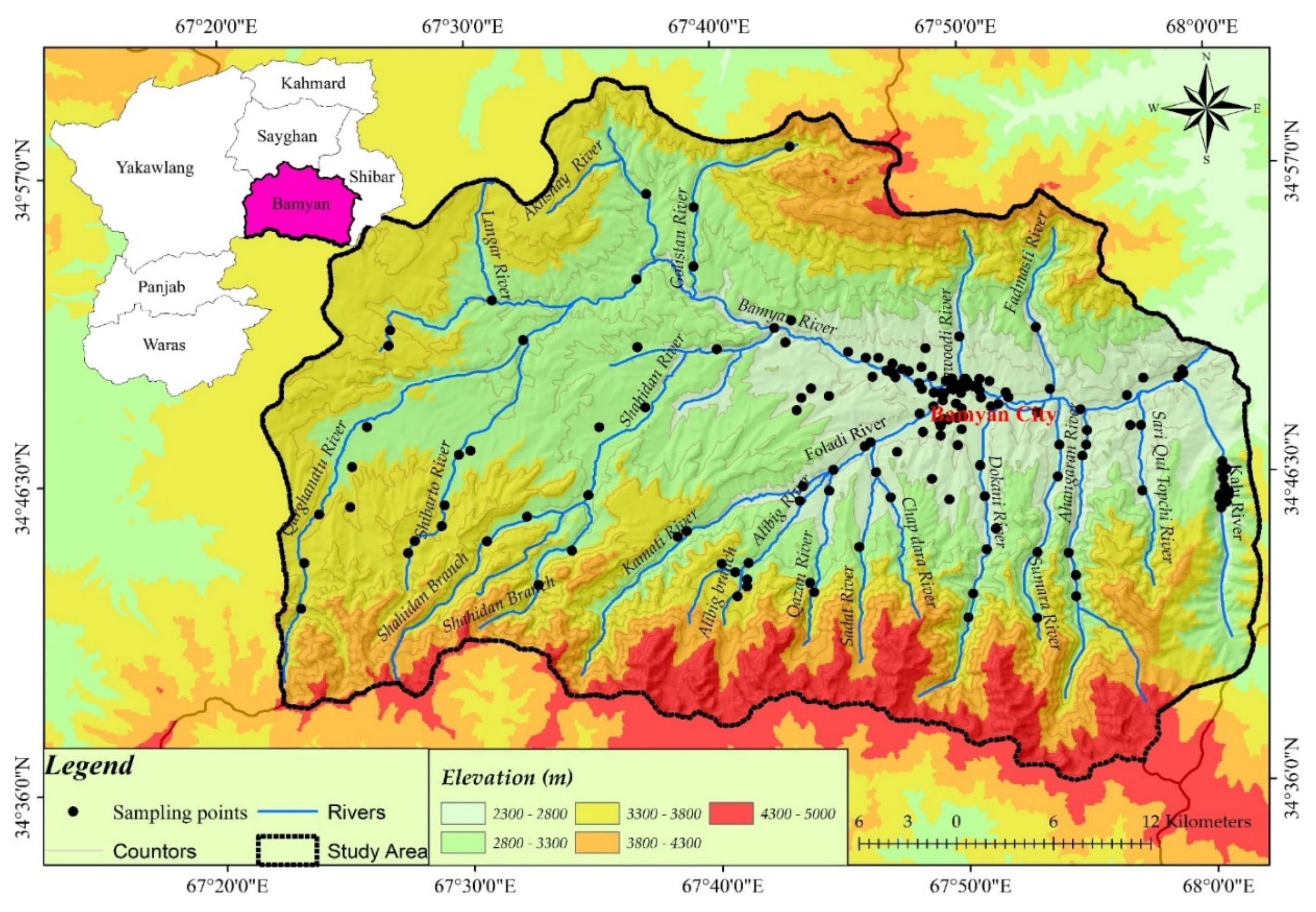
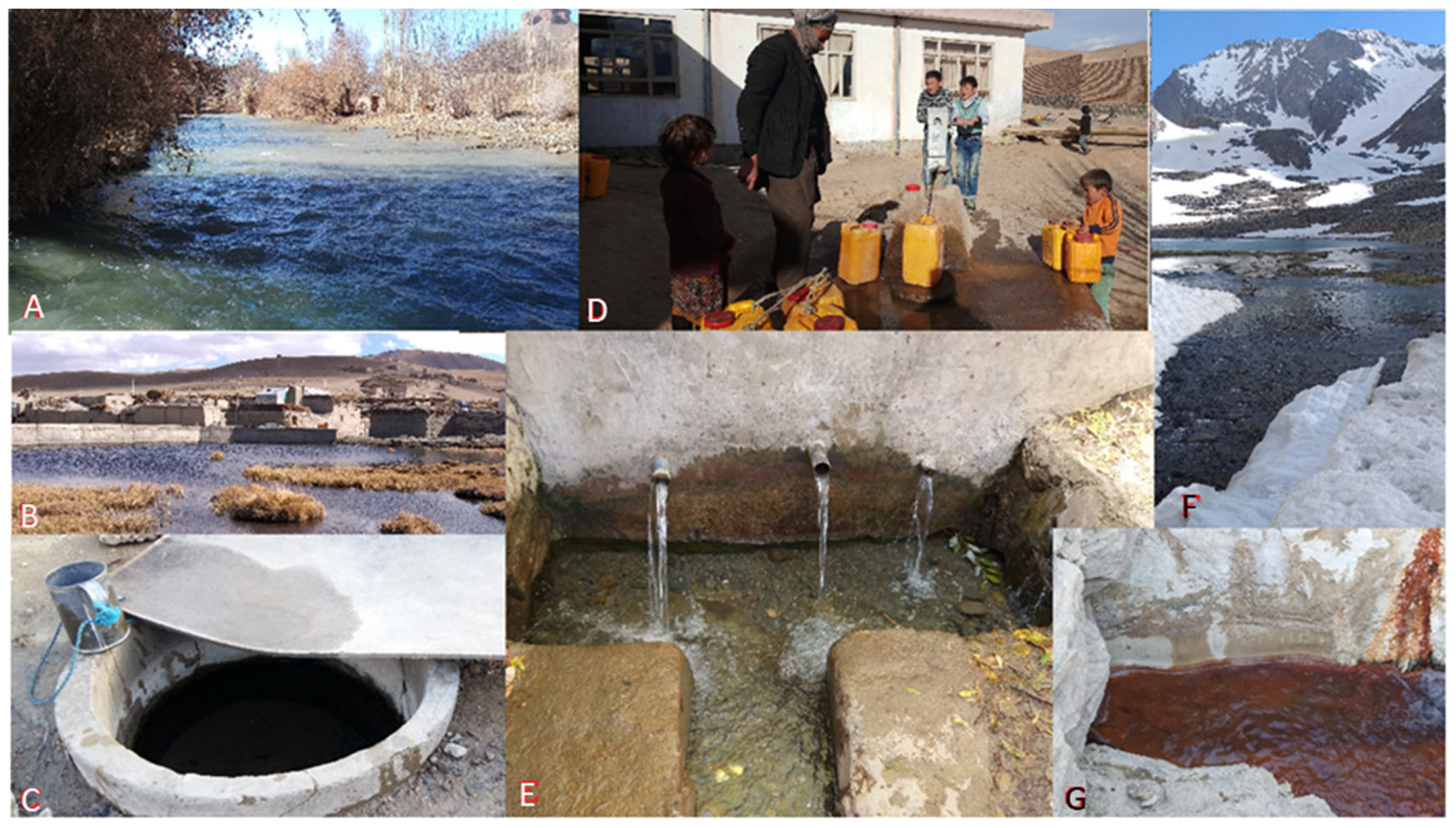
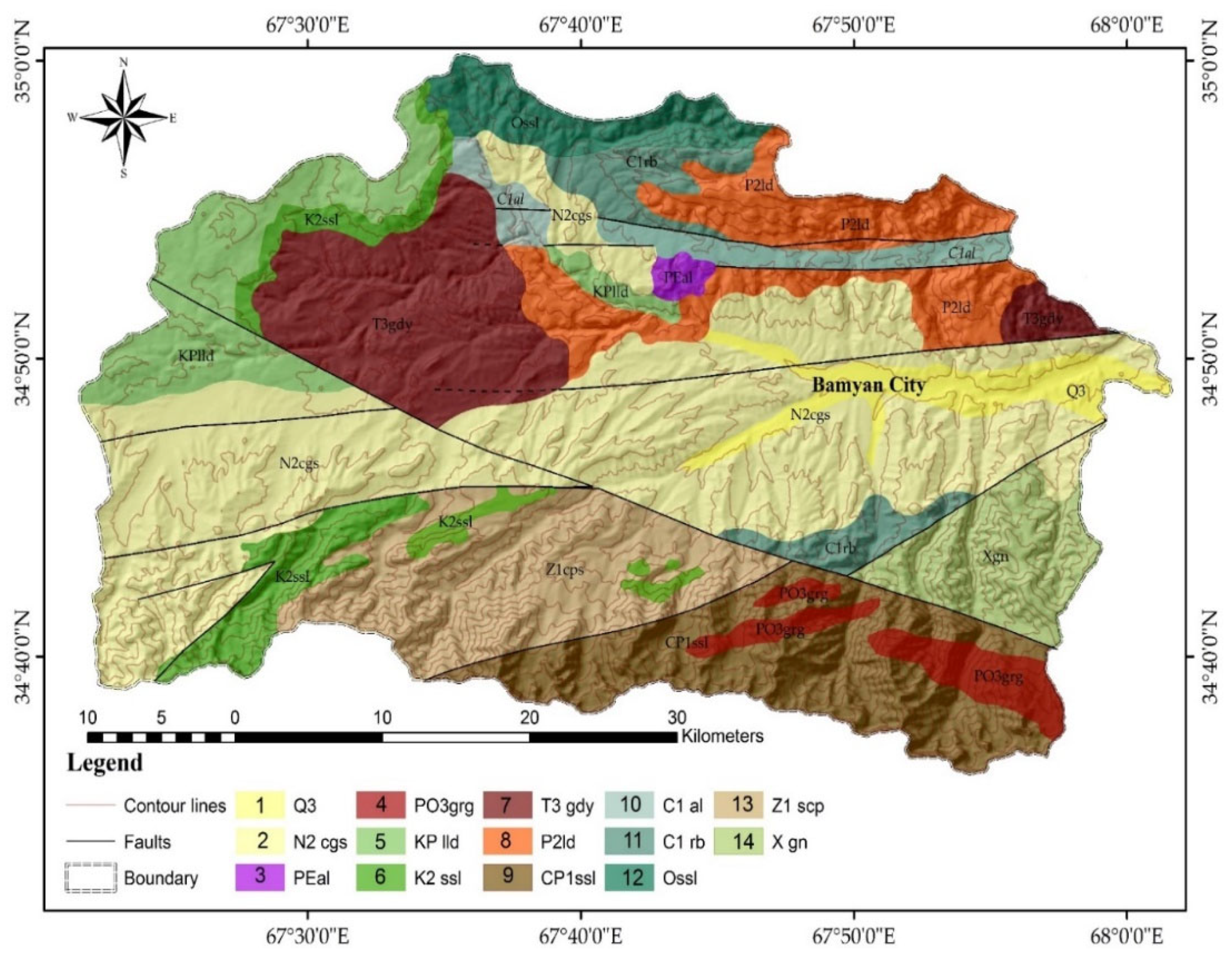
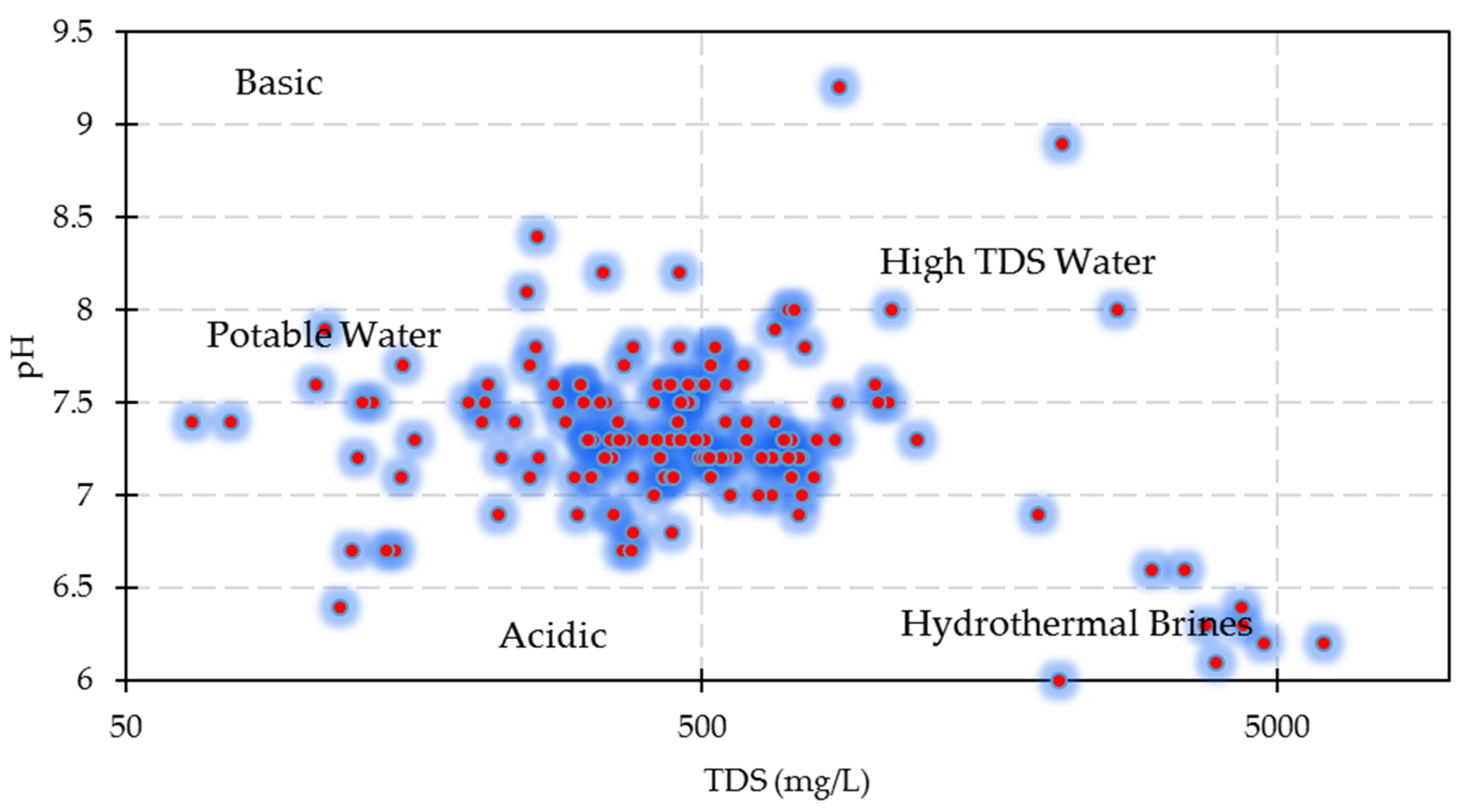
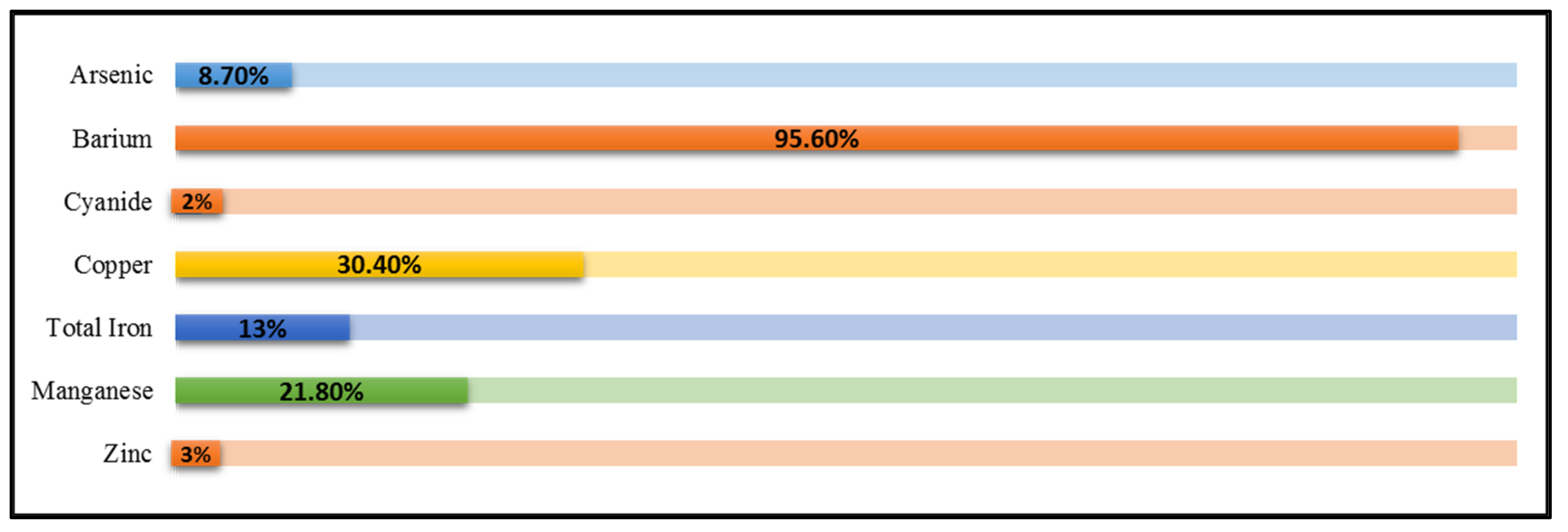
| Regions | Sampling Areas | N (Samples) | Number of Households | Water Resource Types Used (%) | |||||
|---|---|---|---|---|---|---|---|---|---|
| Water Supply | Well | Spring | Canal | River | Glacier | ||||
| Urban | New Town (Isa Khan-Sar Asyab) | 16 | 2900 | 45 | 39 | 0 | 11 | 5 | 0 |
| Old Town (Bazaar) | 22 | 1160 | 12 | 36 | 12 | 10 | 30 | 0 | |
| Sayed Abad | 5 | 2000 | 33 | 43 | 1 | 21 | 2 | 0 | |
| Molla Gholam-Azhdar | 9 | 1800 | 39 | 21 | 10 | 16 | 14 | 0 | |
| Rigshad-Sangchaspan | 11 | 1850 | 40 | 30 | 5 | 12 | 13 | 0 | |
| Zargaran-Jagrakhyl | 5 | 3450 | 44 | 27 | 0 | 21 | 8 | 0 | |
| Rural | Syalayak | 4 | 480 | 0 | 9 | 18 | 28 | 35 | 10 |
| Upper Foladi (Ali big) | 6 | 630 | 6 | 12 | 15 | 35 | 20 | 12 | |
| Lower Foladi Valley | 9 | 490 | 7 | 31 | 1 | 26 | 35 | 0 | |
| Qazan Valley | 5 | 330 | 0 | 8 | 25 | 27 | 25 | 15 | |
| Sadat Valley | 5 | 850 | 2 | 10 | 25 | 26 | 25 | 12 | |
| Khoshkak Valley | 7 | 280 | 12 | 32 | 19 | 20 | 17 | 0 | |
| DoKani Valley | 7 | 250 | 6 | 13 | 25 | 19 | 25 | 13 | |
| Sumara Valley | 4 | 150 | 0 | 14 | 14 | 31 | 29 | 12 | |
| Ahangaran Valley | 4 | 210 | 0 | 10 | 12 | 29 | 35 | 14 | |
| Tupchi | 4 | 640 | 16 | 17 | 18 | 19 | 30 | 0 | |
| Kalu Valley (Lower) | 7 | 530 | 8 | 8 | 17 | 29 | 29 | 8 | |
| Aqrabat-Gulistan | 5 | 250 | 10 | 10 | 20 | 20 | 30 | 10 | |
| Akhshai-Achaqul | 5 | 470 | 19 | 9 | 30 | 30 | 11 | 0 | |
| Qarghanatu | 6 | 230 | 6 | 31 | 6 | 31 | 19 | 6 | |
| Shibartu | 5 | 210 | 9 | 24 | 29 | 35 | 2 | 1 | |
| Shahidan | 10 | 390 | 2 | 14 | 24 | 29 | 24 | 8 | |
| Surkhdar-Khoaja Ali | 14 | 270 | 22 | 20 | 13 | 11 | 33 | 0 | |
| Fatmasti | 4 | 250 | 14 | 14 | 12 | 31 | 29 | 0 | |
| Bamyan River | 16 | ||||||||
| Azhdar Springs | 7 | ||||||||
| Paymury Springs | 15 | ||||||||
| SUM | 217 | 20,070 | 353 | 483 | 351 | 567 | 525 | 121 | |
| % | 15 | 20 | 14 | 24 | 22 | 5 | |||
| WQI | Categories | Rank | Explanation and Potential Uses |
|---|---|---|---|
| 0–25 | Excellent | 1 | Drinking, Irrigation and Industrial |
| 26–50 | Good | 2 | Domestic, Irrigation and Industrial |
| 51–75 | Poor | 3 | Irrigation and Industrial |
| 76–100 | Very Poor | 4 | Irrigation |
| >100 | Unsuitable for drinking | 5 | Restricted use for Irrigation |
| Parameters | Unit | WHO Standard | Weight (wi) | Weighted Factor (Wi) |
|---|---|---|---|---|
| pH | - | 6.5–9.5 | 4 | 0.0666 |
| Turbidity | NTU | 5 | 3 | 0.0500 |
| TDS | mg/L | 1000 | 4 | 0.0666 |
| Arsenic | µg/L | 10 | 5 | 0.0833 |
| Barium | mg/L | 0.7 | 4 | 0.0666 |
| Chloride | mg/L | 250 | 2 | 0.0333 |
| Cyanide | mg/L | 0.07 | 3 | 0.0500 |
| Copper | mg/L | 2 | 4 | 0.0666 |
| Hardness | mg/L | 500 | 2 | 0.0333 |
| Iron | mg/L | 0.3 | 4 | 0.0666 |
| Manganese | mg/L | 0.1 | 4 | 0.0666 |
| Nitrate | mg/L | 50 | 4 | 0.0666 |
| Nitrite | mg/L | 3 | 3 | 0.0500 |
| Sulfate | mg/L | 400 | 4 | 0.0666 |
| Zinc | mg/L | 3 | 4 | 0.0666 |
| Total Coliform | cfu/100 mL | 0 | 3 | 0.0500 |
| Fecal coliform | cfu/100 mL | 0 | 3 | 0.0500 |
| ΣWi | 60 | |||
| Parameter | Max | Min | Avg. |
|---|---|---|---|
| pH | 9.21 | 6.01 | 7.21 |
| Turbidity | 57 | 0.12 | 8.49 |
| TDS | 5139 | 61.57 | 1050.98 |
| Arsenic (µg/L) | 100 | 0 | 4.78 |
| Barium | 7 | 0 | 1.70 |
| Chloride | 1630 | 5.7 | 225.90 |
| Cyanide | 0.022 | 0.002 | 0.01 |
| Copper | 9.02 | 0.02 | 1.70 |
| Hardness | 2615 | 18.5 | 671.76 |
| Iron | 3.49 | 0.01 | 0.37 |
| Manganese | 2.88 | 0.007 | 0.42 |
| Nitrate | 1.11 | 0.004 | 0.10 |
| Nitrite | 17 | 0.5 | 3.47 |
| Sulfate | 1430 | 3 | 265.39 |
| Zinc | 1.18 | 0.08 | 0.31 |
| Total Coliform | 90 | 0 | 18.31 |
| Fecal coliform | 0 | 0 | 0 |
| Regions | Sampling Sites | No of Samples | WQI | |||
|---|---|---|---|---|---|---|
| Water Supply | Well | Spring | River | |||
| Urban | Old Town (Bazaar) | 22 | 8.38 | 13.83 | 5.76 | - |
| New Town | 11 | 21.74 | 10.05 | - | - | |
| Bamyan River | 17 | - | - | - | 65.12 | |
| Molla-Gholam | 5 | 20.63 | 64.76 | - | - | |
| Azhdar | 4 | 71.43 | - | - | - | |
| Sar Asyab | 5 | - | 19.86 | - | - | |
| Sayed Abad | 5 | 21.87 | 10.62 | - | - | |
| Rigshad | 4 | 19.89 | 28.99 | - | - | |
| Sangchaspan | 7 | 21.09 | 30.65 | 19.87 | - | |
| Zargaran | 5 | 10.4 | 13.22 | - | - | |
| Rural | AliBig | 6 | - | - | - | 18.91 |
| Qazan Valley | 5 | - | - | - | 3.06 | |
| Sadat Valley | 5 | - | - | 12.52 | 4.56 | |
| Foladi | 9 | - | 4.18 | - | 32.67 | |
| Khoshkak Valley | 7 | - | 15.71 | - | - | |
| DoKani Valley | 7 | - | - | 11.72 | 14.9 | |
| Ahangaran | 4 | - | - | - | 3.12 | |
| Sumara Valley | 4 | - | - | - | 10.88 | |
| Tupchi | 4 | - | - | 19.03 | - | |
| Kalu River (Paymuri) | 7 | - | - | - | 71.23 | |
| Akhshay-Achaqul | 5 | - | - | 27.51 | - | |
| Aqrabat-Gulistan | 5 | - | - | 28.60 | - | |
| Fatmasti | 4 | - | 24.01 | 22.86 | - | |
| Khoja Ali | 10 | - | - | 17.03 | 62.00 | |
| Qarghanatu | 6 | - | - | - | 59.22 | |
| Shahidan | 10 | - | - | 11.46 | 60.71 | |
| Shibartu | 4 | - | - | 21.69 | - | |
| Surkhdar | 4 | 18.98 | 15.91 | - | - | |
| Brines | Azhdar Salty Springs | 7 | - | - | 408.1 | - |
| Paymuri Hot springs | 15 | - | - | 717.4 | - | |
| Dokani Hot Springs | 1 | - | - | 311.8 | - | |
| Shahidan Hot Springs | 1 | - | - | 371.1 | - | |
| Syalayak | 1 | - | - | 98.32 | - | |
| Dahane-Ahangaran Salty Spring | 1 | - | - | 567.6 | - | |
| pH | Turbidity | TDS | Arsenic | Barium | Chloride | Cyanide | Copper | Hardness | Total Iron | Manganese | Nitrate | Nitrite | Sulfate | Zinc | Total Coliform | |
|---|---|---|---|---|---|---|---|---|---|---|---|---|---|---|---|---|
| pH | 1 | |||||||||||||||
| Turbidity | −0.75 | 1 | ||||||||||||||
| TDS | −0.83 | 0.61 | 1 | |||||||||||||
| Arsenic | −0.43 | 0.47 | 0.54 | 1 | ||||||||||||
| Barium | −0.78 | 0.59 | 0.97 | 0.56 | 1 | |||||||||||
| Chloride | −0.76 | 0.60 | 0.97 | 0.55 | 0.98 | 1 | ||||||||||
| Cyanide | −0.76 | 0.75 | 0.83 | 0.81 | 0.83 | 0.85 | 1 | |||||||||
| Copper | −0.89 | 0.89 | 0.76 | 0.40 | 0.68 | 0.68 | 0.74 | 1 | ||||||||
| Hardness | −0.85 | 0.61 | 0.99 | 0.56 | 0.95 | 0.93 | 0.82 | 0.79 | 1 | |||||||
| Total Iron | −0.71 | 0.77 | 0.79 | 0.81 | 0.82 | 0.83 | 0.92 | 0.71 | 0.76 | 1 | ||||||
| Manganese | −0.82 | 0.59 | 0.93 | 0.62 | 0.89 | 0.84 | 0.80 | 0.76 | 0.96 | 0.75 | 1 | |||||
| Nitrate | −0.56 | 0.53 | 0.80 | 0.80 | 0.86 | 0.88 | 0.87 | 0.46 | 0.75 | 0.90 | 0.72 | 1 | ||||
| Nitrite | −0.42 | 0.51 | 0.66 | 0.81 | 0.73 | 0.73 | 0.78 | 0.38 | 0.63 | 0.84 | 0.62 | 0.92 | 1 | |||
| Sulfate | −0.80 | 0.61 | 1.00 | 0.59 | 0.98 | 0.98 | 0.86 | 0.74 | 0.98 | 0.82 | 0.92 | 0.85 | 0.71 | 1 | ||
| Zinc | −0.81 | 0.63 | 0.95 | 0.39 | 0.93 | 0.90 | 0.73 | 0.77 | 0.95 | 0.70 | 0.91 | 0.69 | 0.59 | 0.93 | 1 | |
| Total Coliform | 0.28 | −0.35 | −0.32 | −0.23 | −0.18 | −0.30 | −0.32 | −0.40 | −0.29 | −0.23 | −0.34 | 0.02 | 0.03 | −0.30 | −0.19 | 1 |
Publisher’s Note: MDPI stays neutral with regard to jurisdictional claims in published maps and institutional affiliations. |
© 2022 by the authors. Licensee MDPI, Basel, Switzerland. This article is an open access article distributed under the terms and conditions of the Creative Commons Attribution (CC BY) license (https://creativecommons.org/licenses/by/4.0/).
Share and Cite
Malistani, H.A.; Jawadi, H.A.; Sidle, R.C.; Khawary, M.; Khan, A.A. Water Resources and Water Quality Assessment, Central Bamyan, Afghanistan. Water 2022, 14, 3060. https://doi.org/10.3390/w14193060
Malistani HA, Jawadi HA, Sidle RC, Khawary M, Khan AA. Water Resources and Water Quality Assessment, Central Bamyan, Afghanistan. Water. 2022; 14(19):3060. https://doi.org/10.3390/w14193060
Chicago/Turabian StyleMalistani, Hasan Ali, Hussain Ali Jawadi, Roy C. Sidle, Masuma Khawary, and Aziz Ali Khan. 2022. "Water Resources and Water Quality Assessment, Central Bamyan, Afghanistan" Water 14, no. 19: 3060. https://doi.org/10.3390/w14193060
APA StyleMalistani, H. A., Jawadi, H. A., Sidle, R. C., Khawary, M., & Khan, A. A. (2022). Water Resources and Water Quality Assessment, Central Bamyan, Afghanistan. Water, 14(19), 3060. https://doi.org/10.3390/w14193060








